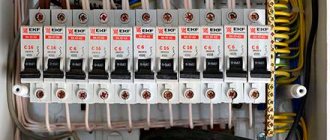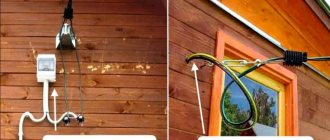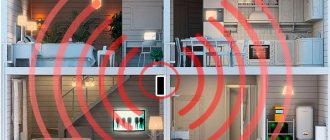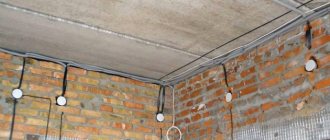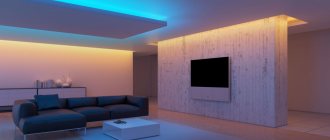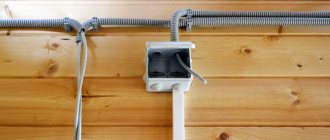Distribution boards make it possible to ensure a safe power supply for any facility: from private homes to large industrial enterprises. Depending on their purpose, switchboards may include a wide variety of equipment: protective, distribution, control, as well as metering devices for consumed electricity. In order not to make a mistake with your choice, it is advisable to familiarize yourself in advance with the types, purposes and capabilities of the most popular models of electrical panels.
Switchboard components
There is an automatic circuit breaker at the input to protect the wiring from short circuits; it de-energizes further circuits during overloads. In emergency situations, the cables overheat, which leads to a fire. Input circuit breakers are installed first in the electrical panel. Assembling an electrical panel involves placing a minimum of switching devices related to a separate housing or floor.
Standard set of modules:
- meter to determine the electricity used;
- An RCD with an automatic device or a difavtomatic device, sometimes several such devices;
- switching terminals, buses, combs, etc.;
- fuses and equipment for control and protection;
- line surge relay;
- sometimes they install low-current networks, for example, LAN or cable television.
A DIN rail is provided for mounting automatic breakers, while there are places on the metal strip where these devices are placed using special clamps.
How to create a diagram
- Powerful users consuming more than two kilowatts are grouped. An automatic machine that can withstand the specified loads is installed on each line.
- Dishwashers, washing machines, and air conditioners that require little power are connected to circuit breakers rated at 16 A. Choose a cable with a cross-section of 2.5 mm².
- High-power units will require 25 A circuit breakers; the cross-section of the power cable is increased to 4.6 mm². Such lines are carried out with one whole wire.
- For sockets, circuits are drawn for each room, a three-core wire with a cross-section of 2.5 mm² is designed. Individual branches are placed on the socket in distribution boxes.
Lighting devices are divided into groups, connected to one 1.5 mm² cable, the line will require a machine with an input of 10 A.
Design requirements
Design Rules:
- In residential buildings, the installation of an electrical panel involves continuous enclosing devices to cover live parts. In rooms for special personnel, cabinet doors are installed with mesh or with holes. In any case, the common panels on the sites are equipped with locks.
- After the switch, according to the instructions, general measuring settings are installed. From left to right, RCDs of the group category are installed, for example, in the kitchen, bathroom, for lighting, sockets.
- Next, automatic breakers are designed in order: lighting circuit, common sockets, dedicated lines for the washing machine, electric boiler, water heater and others.
Regulatory documents and technical specifications for the design of electrical panels in residential buildings are found in the text SP 31.110 - 2003.
Calculation of the number of seats in the panel
The size of the housing must accommodate all the provided modules and fit into the wall niche. Dimensions are selected after determining the list of devices, and it is advisable to leave room for reserve.
Consider the following:
- standard single machine - 17.5 mm, double - 35 mm, triple - 52.6 mm;
- two-module RCD for 1 phase - 35 mm;
- four-module RCD for 3 phases - 70 mm;
- two-module difavtomat for 1 phase - 70 mm;
- terminal block on DIN rail - 17.5 mm per 1 module;
- counter 105 – 140 mm;
- three-module voltage relay - 52.5 mm;
- socket on DIN rail - 52.5 mm.
Valera
The voice of the construction guru
Ask a Question
The devices are attached to a DIN rail, the standard width of which is 35 mm. The socket and relay are optional modules. If it is not possible to increase the size of the box, they can be neglected. If, for example, you have 20 required modules, choose a panel in which you can assemble up to 24 devices.
Scheme for several groups
Electricity supplied to the house is evenly distributed among consumers. Three-phase input is divided into groups of units according to power.
There are several standard schemes:
- Scheme No. 1. A double circuit breaker is installed at the input, and its rating is no more than the input current. Switches are placed after the machine, grouped from left to right. The first to fix the breakers for powerful consumers, then the control mechanisms for sockets, and the last to install the lighting machines.
- Scheme No. 2. To protect against electric shock, an RCD is provided. If there is only one protective device, it is located after the general switch.
- Scheme No. 3. A perfect system when each bundle is connected to its own RCD and separated from the others. So each circuit has its own machine, but the size of the cabinet should be larger.
- Scheme No. 4. The optimal scheme, it provides 2 DIN rails, since all rooms and circuits are connected to their own RCD and automatic circuit breaker. All RCDs are installed on the top bus, and circuit breakers are installed on the bottom bus.
Types of electrical panels
If we do not take into account highly specialized shields, the following types can be distinguished:
- Main distribution board (MSB). They are used as part of substations to distribute power between large consumers. They contain panel measuring instruments and circuit breakers. They are manufactured in buildings of a block-modular design. In addition to circuit breakers, switches are installed at the input and output, allowing you to visually verify that the circuit is broken. Models with thermal and electromagnetic type releases are used as automatic machines.
- Input switchgear (IDU). Functionally, the ASU is similar to the main switchboard. However, it is used on smaller objects (private house, production workshop, separate building). Structurally, ASUs are most often made in the form of metal cabinets with two or three compartments. Inside the compartments there are switching buses, panels and rails for mounting electrical installation products.
- Floor electrical panel (ESB). Allows you to distribute and account for electricity consumption within a single building. In residential buildings, accounting and security are carried out by apartments, in commercial centers by offices, etc. consumer groups. Unlike switchboards of a higher hierarchy (main switchboard, ASU), floor electrical switchboards are necessarily equipped with automatic switches and an electric meter for each group. Optional - RCD, voltage relays, stabilizers, etc.
- Indoor distribution board. It is installed inside the apartment and is designed to distribute power supply along lighting lines, groups of sockets for each room or individual high-power electrical appliances. A separate circuit breaker is installed for each group. If the floor panel does not contain an electric meter and/or RCD, these devices are mounted on the rails of the indoor electrical panel.
With some similarity in functionality, different types of electrical panels allow solving problems of various scales. Hence the variation in their cost, the maximum number of installed devices, as well as in overall dimensions.
Expert opinion: Afanasyev E.V.
Chief editor of the Stroyday.ru project. Engineer.
I recommend that you familiarize yourself with our popular material among readers - how to connect a machine in a panel.
Video - Which electrical panel to choose, comparative review of models
Types of protective automation
Three types of devices are used in an electrical panel:
- circuit breakers;
- RCD;
- difavtomats.
The machine can operate in manual mode or be triggered when a short circuit occurs in the line. The switching device can be electronic or mechanical; it turns the electric current on and off when an abnormal current indicator occurs.
RCD is a protective device for breaking the circuit when a person touches live parts. The device monitors the leakage current that appears in this case. Protects against fire that occurs when electric current leaks through a faulty wire sheath.
The difavtomat combines an RCD device and a circuit breaker in a box, saving space in the distribution panel. The joint kit is more expensive and does not allow you to see the reason for the automatic blackout. There are models with a flag indicating the cause of the malfunction.
Choice for home and apartment
They produce RCDs with rated current values of 16, 25, 40, 63 A. Such indicators indicate the amount of current that the module will pass without turning off. The RCD is not equipped with overcurrent protection (overload, short circuit), so it is combined with a circuit breaker. The parameter is indicated on the back of the instrument housing.
Preparing tools
Installation of the shield is not complete without power tools. The wires in the walls are laid in grooves, to form which they take a wall chaser or a grinder with a circle on the stone. Small volumes are made with a chisel and hammer.
The cabinet is attached to a concrete or brick wall with dowels, so you will need a hammer drill and drills with pobedit tips. On wooden surfaces, a drill is used, and the screws are tightened with a screwdriver.
Electrician's special tools:
- soldering iron, screwdriver sets;
- probe screwdriver;
- portable welding;
- pliers, side cutters;
- current clamps.
A multimeter is needed to determine the electrical parameters of the network and individual devices. They measure electric current, DC and AC voltage, and resistance. A multimeter is used to test fuses, input devices and other devices.
No. 8. Manufacturers of distribution panels
Defective panels will not be able to perform their functions fully, being unable to distribute electric current evenly throughout all rooms. Also, such shields, if necessary, most likely will not turn off the damaged group of circuits automatically, so it is better to trust your safety to trusted manufacturers. The leader in terms of quality is ABB, but its products are expensive. Makel and IEK shields are a little cheaper, but the quality is very good. In terms of design, FOTKA shields made in Greece stand out. It is better to avoid nameless products made in China and Turkey - this is not a case where you can save money.
Finally, we note that, other things being equal, it is better to give preference to shields with a transparent door, which provide easier control over the state of the machines.
Electrical panel assembly
When assembling it yourself, take into account that the machine at the entrance and the electricity meter are sealed by representatives of energy sales . If this is not possible, the entire shield will be sealed or acceptance will be refused. Inside the common electrical panel, a box is assembled into several places (depending on the type of machine), a switch is placed in it, which is sealed. The case is installed on the wall, and a DIN rail is fixed in it.
Step-by-step procedure for assembling the shield:
- fixing elements on the DIN rail according to the diagram;
- connecting modules to the input machine using a comb;
- connecting the phase wire with cables with lugs;
- installation of a zero bus;
- checking fasteners with a screwdriver;
- connecting current, checking operation;
- checking network indicators with a multimeter.
Before operation, make sure that all system elements (sockets, switches, distribution sockets, etc.) are installed and connected.
Connecting components
The shields have a place for cable entry, equipped with a cover. This is important when installing the housing in a niche, when the water supply is difficult. More often this is a group of perforated holes, the size of which is changed by removing the jumpers.
The cable is inserted into a corrugated pipe with a diameter of 16 - 20 mm. The mobility of wires in a pipe can be reduced by using plugs and gland plates. The wires are immediately marked, and the length in the box is left at double the height of the housing.
For connections, jumpers made of wire or bus are used; the first option is suitable for small boxes.
Tires are used in large cabinets , they compare favorably:
- good contact;
- reliability;
- neat look.
Valera
The voice of the construction guru
Ask a Question
Tires for the phase are gray, for zeros are blue, there are universal two-color ones that are used for two options. The working zero from the supply wire enters the zero bus, and then it is removed to circuits going to different rooms.
Connecting protective devices
RCDs and automatic devices are pressed against the DIN rail until a click appears. The wires are connected in accordance with the type of switch (single or double). After installing the devices, their inputs are connected. This is done with jumpers or combs.
Jumper installation:
- cut off pieces of wire of the required length, expose the edges, bend them in an arc, place 2 conductors in the terminal, tighten them;
- long wires are stripped of insulation by 1.5 cm every 5 cm, and the exposed areas are bent with pliers to obtain united arcs;
- areas without insulation are inserted into the sockets and tightened.
Along the phase line, the RCD is connected by dividing the wire into lighting circuit breakers, sockets, and powerful groups. The neutral line is connected after the fire protection. The neutral wire is fixed to a common neutral bus, then from it it is connected to all mounted RCDs and automatic circuit breakers.
Tips and recommendations when choosing an electrical distribution panel
In order not to make a mistake when choosing an electrical panel, before purchasing you need to decide on the following parameters:
- manufacturing material. Plastic samples are most convenient in an apartment or office, where aesthetics are important. For plasterboard walls, built-in models will be optimal. If arranging a niche causes difficulties, then the best solution would be an overhead shield. Metal shields are more appropriate when they need to be placed outdoors. In addition, they are used for switching a large number of consumer groups;
- number of modules. This parameter completely depends on the composition of the electrical installation products in the panel itself, as well as on the number of consumer groups served. The number of seats (modules) is indicated in the name of the panel, the width of the installed modular devices is indicated in the passport. Approximately, a single-pole circuit breaker will take 1 module, a two-pole circuit breaker will take 2 modules, an RCD for one phase will take 3 modules, and for three phases will take 5. The largest width is the electric meter, which occupies from 6 to 8 modules.
Note! The manufacturer is important. As a rule, foreign samples are distinguished by a slightly higher quality of plastic and a richer configuration of the shield. The domestic manufacturer cannot always boast of this, but is able to offer a more budget-friendly option.
Video - Minimum required for assembling a shield
With all the variety of electrical distribution boards, it is necessary to remember that it is best to entrust their assembly to a specialist. In addition, during commissioning, it is advisable to consult with a representative of the energy supply company. This will not only save you from a possible fine, but also save your life.
Testing and commissioning
After installation, they coordinate the operation of the electrical panel, check that the circuit breakers turn off when overloaded, and the RCD turns off when a leakage current appears. First, draw the contacts with a certain force.
Further work order:
- disconnect the load in the circuits (lights, sockets, household appliances);
- use a multimeter to determine that there is no short circuit in the network;
- the device checks the resistance of insulating shells to breakdown;
- check the ability to operate switching modules (diffautomatic devices, RCDs);
- Voltage is supplied to the switchboard and all circuit breakers and protective devices are turned on.
Valera
The voice of the construction guru
Ask a Question
To check, use the “test” key on RCD devices. The protective switches must be disabled, otherwise they must be replaced with serviceable ones. The test is carried out after pulling the mating contacts, since a weak connection may show a false insulation failure during the test.
Schemes for several consumers
Power supply schemes depend on the categories of electrical consumers and their significance. Groups of electrical consumers are distributed by floor, by purpose of the building, by the number of rooms, etc. Usually they separate living rooms and outbuildings, basements and garages, as well as street lighting. If there are many consumers, then not on each individual line, in addition to the main RCD, separate RCDs of lower power should be installed. The kitchen and bathroom must be protected with protective devices according to a separate scheme.
If it is planned to install consumers with a power of up to 2.5 kW, then it is desirable to install separate protection. Household appliances such as a microwave, electric kettle and hair dryer have similar power.
At the stage of developing a power supply scheme for electrical consumers, first of all you should think not about savings, but about safety. All electrical appliances are purchased only from well-known companies, and they cost a lot of money.
Safety precautions
In the panel under each switch there are clear markings and inscriptions indicating that the device belongs to a specific circuit . They use adhesive stickers on which short informative messages are written.
If the cable is damaged, it cannot be repaired, it can only be replaced.
Work is performed on a rubber mat or in current-insulating shoes. Wear rubberized gloves, and the tool handles should be insulated.


